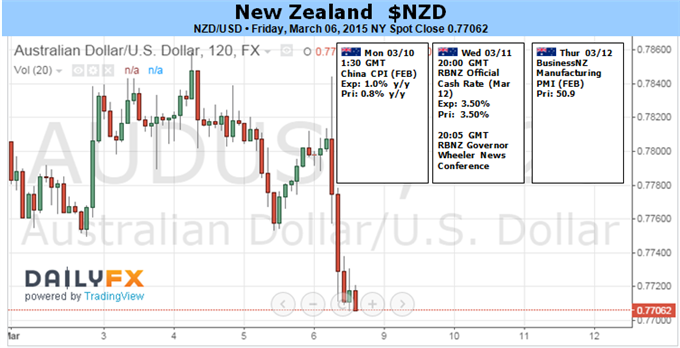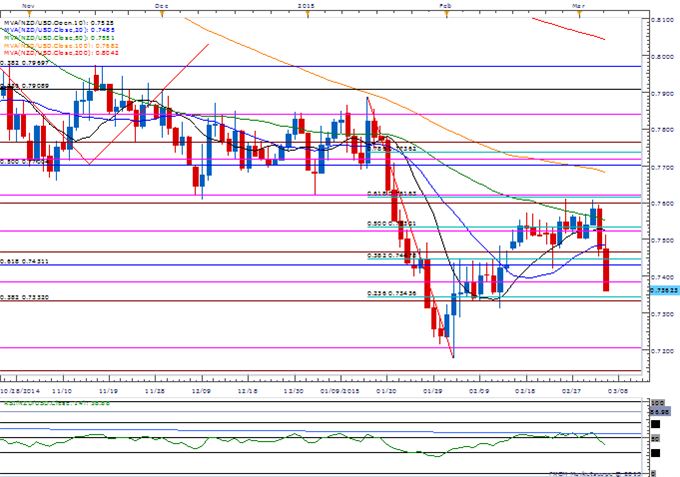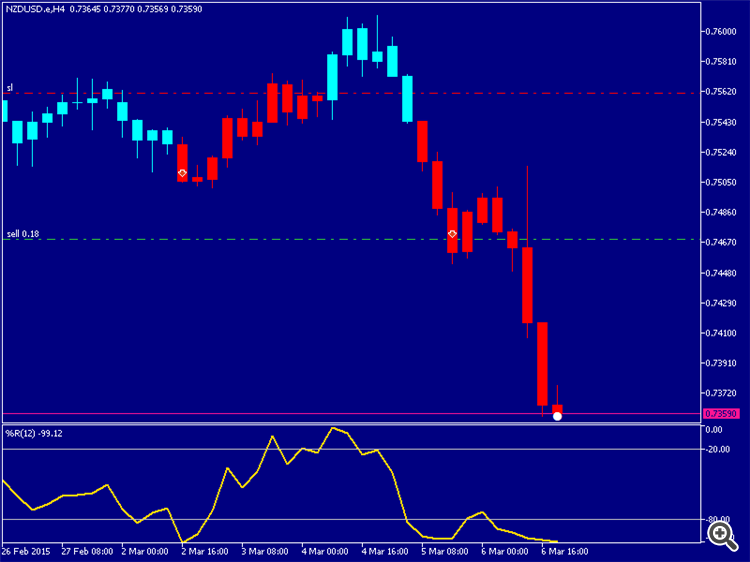Bearish also on my H4 chart settings.
Forum on trading, automated trading systems and testing trading strategies
newdigital, 2015.03.06 21:49
Forex Weekly Outlook Mar. 9-13 (based on forexcrunch aricle)
The US dollar had an excellent week, soaring across the board, most notably against the plunging euro. A rate decision in New Zealand, Employment figures from Australia and Canada, Retail sales, PPI, Unemployment claims and Consumer sentiment from the US are the top events on FX calendar. Let’s see, in detail, the main market movers for this week.
Yet another robust reading from the US job market. The all-important NFP release showed a strong gain of 295,000 positions in February while and the jobless rate fell to a 6.5 year low of 5.5%. The disappointment came from slow wage growth. This raises the chances of a rate hike in June. This boosted the dollar across the board. In the euro-zone, Draghi showed determination on implementing QE, and the euro plunged. The pound followed suit. Elsewhere, an upbeat BOC helped CAD, while no cut from the RBA kept AUD bid. All was lost when the NFP numbers came in.
- NZ rate decision: Wednesday, 20:00. New Zealand’s central bank decided to keep its benchmark Official Cash Rate at 3.5%. The decision was in line with market forecast, however, the RBNZ maintained a tightening policy bias due to weaker than expected growth but stated that future rate adjustments will depend on economic data. RBNZ Governor Graeme Wheeler also voiced his concerns about the unjustified strength of the kiwi and its downside risks to exports. Economists expect the RBNZ will maintain rates this time.
- Australian employment data: Thursday, 0:30. Australian labor market contracted by 12,200 positions in January pushing the unemployment rate to its highest level in 13 years reaching 6.4%. Both readings were worse than expected. Analysts forecasted a job loss of 4,700, expecting only a minor rise of 0.1% in the unemployment rate. Full-time employment fell by 28,100 in January and part-time employment was up 15,900. Australian labor market is expected to expand by15,300 while the unemployment rate is predicted to remain at 6.4%.
- US Retail sales: Thursday, 12:30. U.S. Retail sales slipped 0.8% in January as consumer spending decreased, suggesting the economy started the first quarter on a weaker note. Despite cheap gasoline prices, sales did not pick-up. Economists speculate that consumers were using the extra income to reduce debt and boost savings. Retail sales excluding automobiles, gasoline, building materials and food services plunged 0.9% following a 1.0% slide in the previous month. Retail sales is expected to gain 0.5%, while Core sales are expected to rise 0.6%.
- US Unemployment Claims: Thursday, 12:30. More Americans filled applications for unemployment benefits last week as the long winter stalled further progress in US labor market. Jobless claims edged up 7,000 to 320,000, the highest since May 2014. Analysts expected a lower figure of 293,000. However, the rise in the number of applications does not affect the positive trend in the job market. The four-week average of claims increased to 304,750 from 294,500 the week before. The number of claims is expected to reach 317,000 this week.
- Canadian employment data: Friday, 12:30. The Canadian labor market was boosted by a part-time jobs gain in January, adding 35,400 new positions, well above the 4,700 increase forecasted by analysts. However the report was disappointing since 11,800 full-time positions were lost and the better than expected 6.6% unemployment rate was due to part time job gains. Analysts expect Canadian job figures to decline in the coming months as part-time workers are struggling to find full-time employment and the falling oil prices will also have a negative effect on the labor market. Canadian job market is expected to add 21,300 while the unemployment rate is expected to decline to 6.5%.
- US PPI : Friday, 12:30. U.S. producer prices plunged 0.8%, recording their biggest decline in more than five years due to the ongoing erosion in energy prices. Economists expected a smaller fall of 0.4%. Core prices excluding food, energy, and trade also fell 0.1% after a 0.3% gain in December. Producer prices are predicted to rise 0.2%.
- US UoM Consumer Sentiment: Friday, 14:00. Consumer confidence dropped in February to 93.6 after seven months of gains due to a rise in gasoline prices shifting Americans’ optimism about the economy. The preliminary sentiment index declined to 93.6 from the final January reading of 98.1 the highest since 2004. Economists expected a further rise in sentiment to 98.2. Energy an oil related workers were more concerned about their jobs in case of a fall in production. Consumer sentiment is expected to rise to 95.6.
Forum on trading, automated trading systems and testing trading strategies
newdigital, 2015.03.07 04:13
NZDUSD Fundamentals (based on dailyfx article)
Fundamental Forecast for the New Zealand Dollar: Neutral
- New Zealand Dollar May Suffer Deeper Losses on Dovish RBNZ Rhetoric
- Firming Fed Interest Rate Hike Outlook May Boost Kiwi Selling Pressure

The New Zealand Dollar snapped four consecutive weeks of gains, losing nearly 3 percent against its US counterpart. Selling pressure may continue to swell in the week ahead as a dovish RBNZ monetary policy announcement fuels rate cut speculation even as bets on near-term Fed tightening grow more confident.
The currencywas noticeably stung by January’s about-face in RBNZ rhetoric. The central bank backed away from the hawkish posture on display in December, saying it expected to keep borrowing costs on hold “for some time” and conspicuously noting that future adjustments can take rates “either up or down”.
That seemedto create an opening for the possibility of easing where one was not previously apparent. The Kiwi responded, punctuating two weeks of pre-positioning for a dovish shift with a drop to the lowest level in four years against the greenback. A cautious correction followed, seemingly fueled in equal parts by uncertainty on the US policy front amid disappointing data outcomes and a broader swell in risk appetite.
Sellers returned with a vengeance last week. The RBNZ signaled it is looking for ways to isolate problem areas in the housing market, suggesting it will opt for a surgical approach to cool activity over the blunt instrument of rate hikes. Meanwhile, a strong US payrolls reading fueled a palpable hawkish shift in traders’ Fed rate hike outlook. The report likewise fueled risk aversion, suggesting the prospect of stimulus withdrawal has emerged as a source of worry once again.
The markets don’t expect an outright policy change from the RBNZ. Indeed, priced-in expectations place the probability of a rate cut at a mere 4 percent. Economic news-flow has soured since January’s sit-down however, leaving room for Governor Wheeler to rhetorically build the foundation for a possible downward shift in borrowing costs at subsequent meetings. If that cements probabilities of a cut some time over the next 12 months in the minds of investors, the Kiwi is likely to suffer.
On the US data front, excitations point to a rebound in retail sales and a pickup in consumer confidence (as tracked by a University of Michigan survey). Such outcomes may further bolster Fed tightening bets, weighing on sentiment and amplifying perceptions of the policy divergence between the US and the rest of the G10. Needless to say, that bodes ill for the Kiwi in its own right. It would hurt more so if it came against the backdrop of softening yield prospects at home.
Forum on trading, automated trading systems and testing trading strategies
newdigital, 2015.03.07 09:40
AUD/USD Threatens Bullish Momentum- NZD/USD Carves Top Ahead of RBNZ (based on dailyfx article)
- AUD/USD Outperforms to Retain Range- China Event Risk in Focus.
- NZD/USD Retains Bearish RSI Momentum Ahead of RBNZ Meeting.
- USDOLLAR Rallies to Fresh High on Strong Non-Farm Payrolls (NFP).

- NZD/USD appears to have a carved a near-term top as it continues to come off of former support zone around 0.7590 (38.2% expansion) to 0.7620 (50% expansion); downside targets remain favored as the RSI retains the bearish momentum.
- Despite the verbal intervention, the Reserve Bank of New Zealand’s (RBNZ) forward-guidance for monetary policy may heavily influence the near-term outlook for NZD/USD.
- Close below 0.7330 (61.8% expansion) to 0.7340 (23.6% retracement) may open the door for fresh lows.
Forum on trading, automated trading systems and testing trading strategies
newdigital, 2015.03.07 13:40
NZD/USD forecast for the week of March 9, 2015, technical analysis
The NZD/USD pair initially tried to break out to the upside during the week, but as you can see above the 0.75 level we have far too much in the way of resistance. On top of that, we believe that this market should continue to go lower based upon the fact that the US dollar continues to strengthen overall, and of course the jobs number out of America was stronger than anticipated. Every time this market rallies, we believe that will continue to selloff. We have no interest whatsoever in buying.
Forum on trading, automated trading systems and testing trading strategies
newdigital, 2015.03.09 01:31
NZD/USD weekly outlook: March 9 - 13 (based on investing.com article)
The New Zealand dollar fell more than 1% against its U.S. counterpart on Friday, as stronger than forecast U.S. nonfarm payrolls data bolstered bets that the Federal Reserve will begin to raise rates sooner rather than later.
NZD/USD hit 0.7358 on Friday, the pair's lowest since February 12, before subsequently consolidating at 0.7362 by close of trade on Friday, down 1.62% for the day and 2.67% lower for the week.
The Labor Department reported that the U.S. economy added 295,000 jobs in February, far more than the 240,000 forecast by economists. The unemployment rate ticked down to 5.5% from 5.7% in January, the lowest since May 2008. Economists had forecast the unemployment rate would fall to 5.6%.
The robust jobs report fuelled expectations that the Federal Reserve will start raising interest rates as early as June, boosting the greenback.
The dollar index, which measures the greenback’s strength against a trade-weighted basket of six major currencies, jumped 1.39% to 97.74 late Friday, the highest since September 2003.
Elsewhere, the euro was weaker against the kiwi after European Central Bank President Mario Draghi confirmed that it will begin purchasing euro zone government bonds on Monday under its new quantitative easing program.
The combined monthly asset purchases will amount to €60 billion per month and are expected to run until September 2016.
In the week ahead, markets will be watching talks on Greece by euro zone finance ministers in Brussels on Monday, while Thursday’s U.S. retail sales report will also be closely watched for further indications on the strength of the recovery.
The outcome of a policy meeting of the Reserve Bank of New Zealand on Wednesday will also be in focus.
Chinese government data on consumer price inflation and industrial production will also be eyed.
On Sunday, China reported a trade surplus of $60.6 billion in the January-February period, compared to expectations for a surplus of $10.8 billion and up from a surplus of $60.0 in January.
Exports surged 48.3% from a year earlier last month, above expectations for a 14.2% increase, while imports tumbled 20.5%, much worse than forecasts for a decline of 10.0%.
The Asian nation is New Zealand's second largest trade partner.
Monday, March 9
- Eurogroup finance ministers are to hold a meeting in Brussels to discuss funding options for Greece.
Tuesday, March 10
- China is to release reports on consumer and producer price inflation.
Wednesday, March 11
- China is to publish reports on industrial production and fixed asset investment.
- The Reserve Bank of New Zealand is to announce its benchmark interest rate and publish its rate statement, which outlines economic conditions and the factors affecting the monetary policy decision.
Thursday, March 12
- The U.S. is to produce data on retail sales and initial jobless claims.
Friday, March 13
- The U.S. is to round up the week with data on producer prices and consumer sentiment.
Forum on trading, automated trading systems and testing trading strategies
newdigital, 2015.03.09 08:47
NZD/USD Technical Analysis: Kiwi Dollar Selloff Accelerates (based on dailyfx article)
- NZD/USD Technical Strategy: Flat
- Support: 0.7340, 0.7256, 0.7171
- Resistance:0.7444, 0.7551, 0.7608

The New Zealand Dollar accelerated
downward against its US counterpart, sliding to the lowest level in a
month. Near-term support is at 0.7340, the 38.2% Fibonacci expansion,
with a break below that on a daily closing basis exposing the 50% level
at 0.7256. Alternatively, a reversal above the 23.6% Fib at 0.7444 opens
the door for a challenge of channel floor support-turned-resistance at
0.7551.
Prices are too close to support to justify entering short from a risk/reward perspective. On the other hand, the absence of a defined bullish reversal signal suggests that taking up the long side is premature. With that in mind, we will remain flat for now.
Forum on trading, automated trading systems and testing trading strategies
newdigital, 2015.03.11 01:28
NZD/USD Down as Traders Await RBNZ Decision (based on marketpulse article)
The Reserve Bank of New Zealand (RBNZ) steps into the limelight this week with its monthly rate statement and subsequent press conference.
On January 28 the RBNZ kept benchmark interest rates on hold at 3.50%. The decision was not unexpected as it was already priced in by the market, but Governor Graeme Wheeler did change his stance regarding the previous statement of keeping the rate at current levels “for some time” into the possibility of a cut or hike if needed. Wheeler also took the opportunity to talk down the NZD as he still thinks it is overvalued.
Current USD strength has depreciated the NZD and put less pressure on the RBNZ to cut rates. A strong U.S. nonfarm payrolls (NFP) report has put pressure on the Federal Reserve to hike rates as soon as June, in turn boosting the USD across the board. NZD/USD was trading around 0.76 before the U.S. NFP and it’s now close to breaking 0.73 ahead of the Kiwi central bank announcement. Meantime, the Federal Open Market Committee’s (FOMC) two-day meeting is just around the corner. Chair Janet Yellen, although maintaining a neutral stance, has hinted that the “patient” language contained in the Fed’s statement could be dropped in the next couple of meetings. That, too, is helping the dollar appreciate.
If D1 price will break 0.7612
resistance level so we may see the secondary market rally with the
possibility to the reversal of the price movement from bearish to the
bullish condition
If not so it will be bearish ranging between 0.7421 and 0.7612 levels
- Recommendation for long: watch D1 price to break 0.7612 for possible buy trade
- Recommendation
to go short: watch D1 price to break 0.7421 support level for possible sell trade
- Trading Summary: bearish
The price broke 0.7421 support level on close D1 bar on Monday with good breakdown started:
- the market price is 0.7260
- today's daily bar was opened at 0.7270
- next support level is 0.7253

If you used my recommendations (support level = sell stop pending order by trading) so you should get about 160 pips in profit by equity (4 digit pips) !
More to follow: if Chinkou Span line (DarkTurcuoise color line on the lift of the chart above) crosses the price from above to below on close D1 bar so the bearish breakdown will be continuing with good profit for all of us.
- Free trading apps
- Over 8,000 signals for copying
- Economic news for exploring financial markets
You agree to website policy and terms of use

W1 price is on secondary ranging within the primary bearish
MN price is located inside Ichimoku cloud/kumo for ranging bearish
If D1 price will break 0.7421 support level on close bar so the primary bearish market condition will be continuing with good breakdown
If D1 price will break 0.7612 resistance level so we may see the secondary market rally with the possibility to the reversal of the price movement from bearish to the bullish condition
If not so it will be bearish ranging between 0.7421 and 0.7612 levels
UPCOMING EVENTS (high/medium impacted news events which may be affected on NZDUSD price movement for this coming week)
2015-03-08 21:45 GMT (or 23:45 MQ MT5 time) | [NZD - Manufacturing Sales]
2015-03-10 01:30 GMT (or 03:30 MQ MT5 time) | [CNY - CPI]
2015-03-10 01:30 GMT (or 03:30 MQ MT5 time) | [CNY - PPI]
2015-03-11 05:30 GMT (or 07:30 MQ MT5 time) | [CNY - Industrial Production]
2015-03-11 20:00 GMT (or 22:00 MQ MT5 time) | [NZD - Official Cash Rate]
2015-03-12 12:30 GMT (or 14:30 MQ MT5 time) | [USD - Retail Sales]
2015-03-12 21:30 GMT (or 23:30 MQ MT5 time) | [NZD - Business NZ Manufacturing Index]
2015-03-13 12:30 GMT (or 14:30 MQ MT5 time) | [USD - PPI]
Please note : some US (and CNY) high/medium impacted news events (incl speeches) are also affected on NZDUSD price movement
SUMMARY : bearish
TREND : breakdown